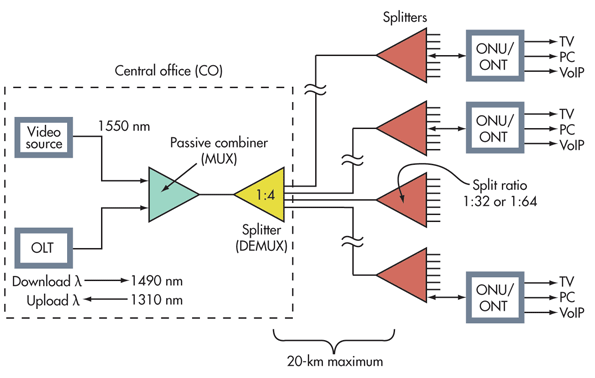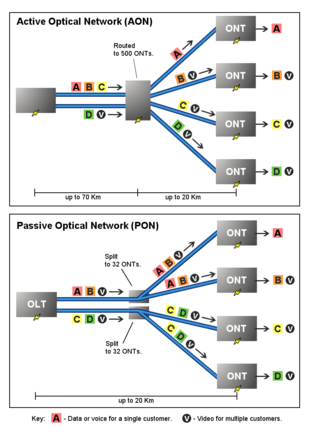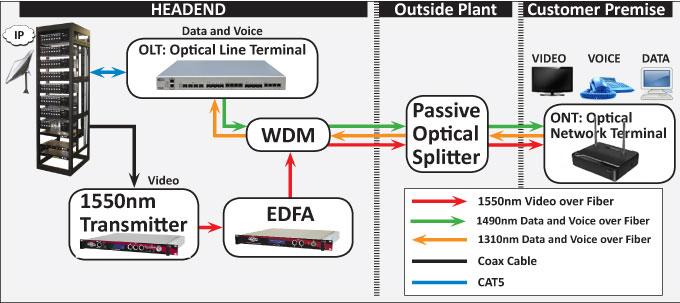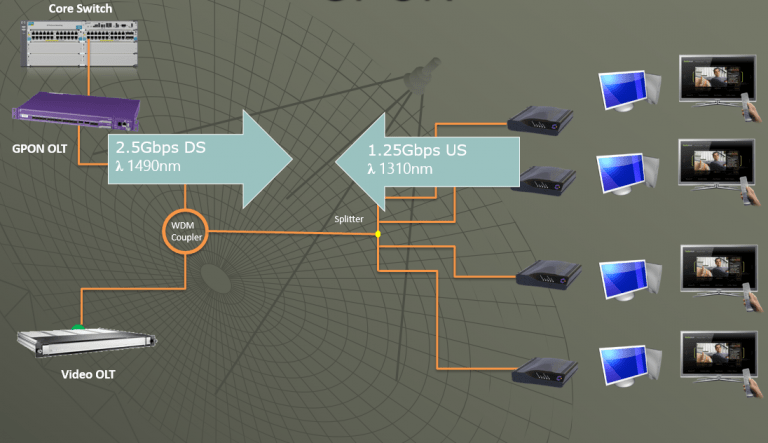
PONs (passive optical networks), Active Ethernet, and RF over glass (RFoG) are the primary FTTH/FTTP/FTTB technologies. PONs include GPON, EPON/GEPON, DOCSIS PON (D-PON), and WDM PON.
A Passive optical network (PON) is used to provide fiber to the end consumer, both domestic and commercial. Its distinguishing feature is that it implements a point-to-multipoint architecture, in which unpowered fiber optic splitters are used to enable a single optical fiber to serve multiple end-points. The end-points are often individual customers, rather than commercial. A PON does not have to provision individual fibers between the hub and customer. They are often referred to as the “last mile” between an ISP and customer.
A PON fiber network only uses fiber and passive components like splitters and combiners rather than active components like amplifiers, repeaters, or shaping circuits. Such networks cost significantly less than those using active components. The main disadvantage is a shorter range of coverage limited by signal strength. While an active optical network (AON) can cover a range to about 100 km (62 miles), a PON is typically limited to fiber cable runs of up to 20 km.

The most popular versions of PONs are EPON and GPON. These short-haul networks of fiber-optical cable are used for Internet access, voice over Internet protocol (VoIP), and digital TV delivery in metropolitan areas. Other uses include backhaul connections for cellular basestations, Wi-Fi hotspots, and even distributed antenna systems (DAS). The primary differences between them lie in the protocols used for downstream and upstream communications.
PONs also are called fiber to the home (FTTH) networks. The term FTTx is used to state how far a fiber run is. In FTTH, x is for home. You may also see it called FTTP or fiber to the premises. Another variation is FTTB for fiber to the building. These three versions define systems where the fiber runs all the way from the service provider to the customer. In other forms, the fiber is not run all the way to the customer. Instead, it is run to an interim node in the neighborhood. This is called FTTN for fiber to the node. Another variation is FTTC, or fiber to the curb. Here too the fiber does not run all the way to the home. FTTC and FTTN networks may use a customer’s unshielded twisted-pair (UTP) copper telephone line to extend the services at lower cost. For example, a fast ADSL line carries the fiber data to the customer’s devices.
The typical PON arrangement is a point to multi-point (P2MP) network where a central optical line terminal (OLT) at the service provider’s facility distributes TV or Internet service to as many as 16 to 128 customers per fiber line (see the figure). Optical splitters, passive optical devices that divide a single optical signal into multiple equal but lower-power signals, distribute the signals to users. An optical network unit (ONU) terminates the PON at the customer’s home. The ONU usually communicates with an optical network terminal (ONT), which may be a separate box that connects the PON to TV sets, telephones, computers, or a wireless router. The ONU/ONT may be one device.
In the basic method of operation for downstream distribution on one wavelength of light from OLT to ONU/ONT, all customers receive the same data. The ONU recognizes data targeted at each user. For the upstream from ONU to OLT, a time division multiplex (TDM) technique is used where each user is assigned a timeslot on a different wavelength of light. With this arrangement, the splitters act as power combiners. The upstream transmissions, called burst-mode operations, occur at random as a user needs to send data. The system assigns a slot as needed. Because the TDM method involves multiple users on a single transmission, the upstream data rate is always slower than the downstream rate.
Gigabit PON -GPON
In the late 1990s, the International Telecommunications Union (ITU) created the APON standard, which used the Asynchronous Transfer Mode (ATM) for long-haul packet transmission. Since ATM is no longer used, a newer version was created called the broadband PON, or BPON. Designated as ITU-T G.983, this standard provided for 622 Mbits/s downstream and 155 Mbits/s upstream.
While BPON may still be used in some systems, most current networks use GPON, or Gigabit PON. The ITU-T standard is G.984. It delivers 2.488 Gbits/s downstream and 1.244 Gbits/s upstream.
GPON uses optical wavelength division multiplexing (WDM) so a single fiber can be used for both downstream and upstream data. A laser on a wavelength (λ) of 1490 nm transmits downstream data. Upstream data transmits on a wavelength of 1310 nm. If TV is being distributed, a wavelength of 1550 nm is used.
While each ONU gets the full downstream rate of 2.488 Gbits/s, GPON uses a time division multiple access (TDMA) format to allocate a specific timeslot to each user. This divides the bandwidth so each user gets a fraction such as 100 Mbits/s depending upon how the service provider allocates it.
The upstream rate is less than the maximum because it is shared with other ONUs in a TDMA scheme. The OLT determines the distance and time delay of each subscriber. Then software provides a way to allot timeslots to upstream data for each user.
The typical split of a single fiber is 1:32 or 1:64. That means each fiber can serve up to 32 or 64 subscribers. Split ratios up to 1:128 are possible in some systems.
As for data format, the GPON packets can handle ATM packets directly. Recall that ATM packages everything in 53-byte packets with 48 for data and 5 for overhead. GPON also uses a generic encapsulation method to carry other protocols. It can encapsulate Ethernet, IP, TCP, UDP, T1/E1, video, VoIP, or other protocols as called for by the data transmission. Minimum packet size is 53 bytes, and the maximum is 1518. Advanced Encryption Standard (AES) encryption is used downstream only.
The latest version of GPON is a 10-Gigabit version called XGPON, or 10G-PON. As the demand for video and over the top (OTT) TV services has increased, there is an increasing need to boost line rates to handle the massive data of high-definition video. XGPON serves this purpose. The ITU standard is G.987
XGPON’s maximum rate is 10 Gbits/s (9.95328) downstream and 2.5 Gbits/s (2.48832) upstream. Different WDM wavelengths are used, 1577 nm downstream and 1270 nm upstream. This allows 10-Gbit/s service to coexist on the same fiber with standard GPON. Optical split is 1:128, and data formatting is the same as GPON. Maximum range is still 20 km. XGPON is not yet widely implemented but provides an excellent upgrade path for service providers and customers.
GPON Optical Network Terminal devices deliver high-speed voice, data and video services to residential and business subscribers. They leverage the extraordinary bandwidth of GPON technology, providing a reliable, long-reach last-mile connection by extending the public high-bandwidth network to those living and working in remote homes and home offices.
Typical GPON Network.
GPON is specified to be a single or dual fiber system, but almost all GPON systems are single fiber like virtually all popular FTTH technologies. There is little reason to use dual fibers, although this option is indeed allowed in the standard.

Typical GPON Network with RF Overlay
The RF overlay incorporates standard and high definition video into the fiber network using the 1550nm transmitter and EDFA. For cost savings, this topology is often used over the GPON IP solution.

EPON
The Institute of Electrical and Electronic Engineers (IEEE) developed another newer PON standard. Based on the Ethernet standard 802.3, EPON 802.3ah specifies a similar passive network with a range of up to 20 km. It uses WDM with the same optical frequencies as GPON and TDMA. The raw line data rate is 1.25 Gbits/s in both the downstream and upstream directions. You will sometimes hear the network referred to as Gigabit Ethernet PON or GEPON.
EPON is fully compatible with other Ethernet standards, so no conversion or encapsulation is necessary when connecting to Ethernet-based networks on either end. The same Ethernet frame is used with a payload of up to 1518 bytes. EPON does not use the CSMA/CD access method used in other versions of Ethernet. Since Ethernet is the primary networking technology used in local-area networks (LANs) and now in metro-area networks (MANs), no protocol conversion is needed.
There is also a 10-Gbit/s Ethernet version designated 802.3av. The actual line rate is 10.3125 Gbits/s. The primary mode is 10 Gbits/s upstream as well as downstream. A variation uses 10 Gbits/s downstream and 1Gbit/s upstream. The 10-Gbit/s versions use different optical wavelengths on the fiber, 1575 to 1580 nm downstream and 1260 to 1280 nm upstream so the 10-Gbit/s system can be wavelength multiplexed on the same fiber as a standard 1-Gbit/s system.
Why Choose GPON?
GPON gives the end user the ability to consolidate multiple services onto a single fibre transport network. This technology reduces costs and infrastructure while increasing bandwidth. It provides 2.5 GB/s of downstream bandwidth and 1.25 GB/s upstream divided by the split ratio to each customer delivering a customizable, high capacity fibre network for forms of IP based services.
These networks are the perfect solution for environments with multiple separated nodes / points or buildings. GPON provides for a large range of benefits that enable rapid, flexible, mass‐market fibre deployments at the lowest possible cost of ownership and rollout.
Combining full IP‐based connectivity and the latest fibre to the end point innovations, gigabit passive optical networks (GPON) are increasingly appearing as the key mature network technology.
- GPON supports triple – play services, providing competitive all-services solutions.
- GPON supports high-bandwidth transmission to break down the bandwidth bottleneck of the access over twisted pair cables.
- GPON supports the long-reach (up to 20 km) service coverage to overcome the obstacle of the access technology over twisted pair cables and reduce the network nodes.
- With complete standards and high technical requirements, GPON supports integrated services in a good way.
- GPON is a fully optical architecture option that offers the best of all worlds
- A GPON system consists of an optical line terminal (OLT) that connects several optical network terminals (ONTs) together using a passive optical distribution network (ODN).

References
- Lippi’s, Nicholas, GPON vs. Gigabit Ethernet in Campus Networking, February 2012.
- Trots, Joe, An Overview of GPON in the Access Network, presentation for Ericsson, November 2008.
- PON/Systems by LIGHTWAVE
- Passive optical network by Wikipedia

4 ports epon olt price